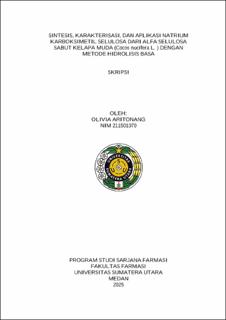| dc.description.abstract | Background: Young coconut coir contains 69% cellulose making it a potential
source for sodium carboxymethyl cellulose production.
Objective: This study aimed to utilize young coconut coir and determine the
optimal sodium hydroxide concentration in the delignification process to obtain
high quality alpha cellulose and produce sodium carboxymethyl cellulose as a
pharmaceutical additive, specifically a gelling agent.
Method: The isolation process started with delignification using the alkaline
hydrolysis method with sodium hydroxide concentrations of 5%, 10%, and 15%,
followed by bleaching with alkaline hydrogen peroxide (AHP), and purification
with 17.5% sodium hydroxide. The obtained alpha cellulose was then synthesized
into sodium carbocymethyl cellulose, characterized, and applied as a gelling agent..
Results: High quality alpha-cellulose characteristics were obtained from
delignification using 10% NaOH, yielding 17.73 ± 1.39% in the form of fine, white,
odorless fibers. Sodium carboxymetyhl cellulose produced from young coconut
coir exhibited good characteristics, confirmed through SEM, FT-IR, and XRD
analyses. The degree of substitution was 0.55 (grade quality II), the viscosity of a
2% Na-CMC solution was 401.33 ± 12.76 cP (medium viscosity), and the
crystallinity percentage was 26%, indicating low crystallinity. Sodium
carboxymethyl cellulose derived from young coconut coir, applied as a gelling
agent in ibuprofen gel preparation, met the physical evaluation and stability tests at
room temperature (28±2°C), low temperature (4±2°C), and high temperature
(40±2°C), based on organoleptic, pH, and viscosity assessments.
Conclusion: The alkaline hydrolysis delignification method effectively produces
alpha-cellulose from young coconut fiber. The resulting Na-CMC has the potential
to serve as a gelling agent that meets industry standards. | en_US |


